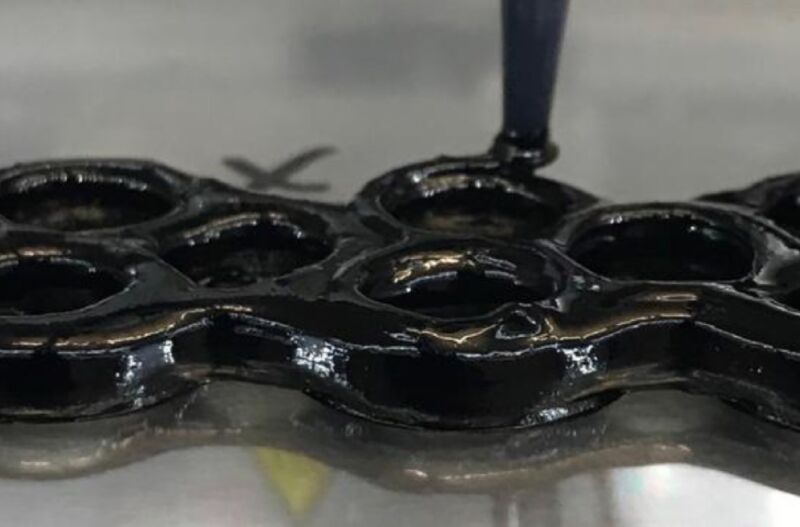Scientists are keen to develop new materials for lightweight, flexible, and affordable wearable electronics so that, one day, dropping our smartphones won't result in irreparable damage. One team at the University of California, Merced, has made conductive polymer films that actually toughen up in response to impact rather than breaking apart, much like mixing corn starch and water in appropriate amounts produces a slurry that is liquid when stirred slowly but hardens when you punch it (i.e., "oobleck"). They described their work in a talk at this week's meeting of the American Chemical Society in New Orleans.
"Polymer-based electronics are very promising," said Di Wu, a postdoc in materials science at UCM. "We want to make the polymer electronics lighter, cheaper, and smarter. [With our] system, [the polymers] can become tougher and stronger when you make a sudden movement, but... flexible when you just do your daily, routine movement. They are not constantly rigid or constantly flexible. They just respond to your body movement."
As we've previously reported, oobleck is simple and easy to make. Mix one part water to two parts corn starch, add a dash of food coloring for fun, and you've got oobleck, which behaves as either a liquid or a solid, depending on how much stress is applied. Stir it slowly and steadily and it's a liquid. Punch it hard and it turns more solid under your fist. It's a classic example of a non-Newtonian fluid.
In an ideal fluid, the viscosity largely depends on temperature and pressure: Water will continue to flow regardless of other forces acting upon it, such as being stirred or mixed. In a non-Newtonian fluid, the viscosity changes in response to an applied strain or shearing force, thereby straddling the boundary between liquid and solid behavior. Stirring a cup of water produces a shearing force, and the water shears to move out of the way. The viscosity remains unchanged. But for non-Newtonian fluids like oobleck, the viscosity changes when a shearing force is applied.
Ketchup, for instance, is a shear-thickening non-Newtonian fluid, which is one reason smacking the bottom of the bottle doesn't make the ketchup come out any faster; the application of force increases the viscosity. Yogurt, gravy, mud, and pudding are other examples. And so is oobleck. (The name derives from a 1949 Dr. Seuss children's book, Bartholomew and the Oobleck.) By contrast, non-drip paint exhibits a "shear-thinning" effect, brushing on easily but becoming more viscous once it's on the wall. Last year, MIT scientists confirmed that the friction between particles was critical to that liquid-to-solid transition, identifying a tipping point when the friction reached a certain level and the viscosity abruptly increased.
Wu works in the lab of materials scientist Yue (Jessica) Wang, who decided to try to mimic the shear-thickening behavior of oobleck in a polymer material. Flexible polymer electronics are usually made by linking together conjugated conductive polymers, which are long and thin, like spaghetti. But these materials will still break apart in response to particularly large and/or rapid impacts.
So Wu and Wang decided to combine the spaghetti-like polymers with shorter polyaniline molecules and poly(3,4-ethylenedioxythiophene) polystyrene sulfonate, or PEDOT:PSS—four different polymers in all. Two of the four have a positive charge, and two have a negative charge. They used that mixture to make stretchy films and then tested the mechanical properties.
Lo and behold, the films behaved very much like oobleck, deforming and stretching in response to impact rather than breaking apart. Wang likened the structure to a big bowl of spaghetti and meatballs since the positively charged molecules don't like water and therefore cluster into ball-like microstructures. She and Wu suggest that those microstructures absorb impact energy, flattening without breaking apart. And it doesn't take much PEDOT:PSS to get this effect: just 10 percent was sufficient.
Further experiments identified an even more effective additive: positively charged 1,3-propanediamine nanoparticles. These particles can weaken the "meatball" polymer interactions just enough so that they can deform even more in response to impacts, while strengthening the interactions between the entangled long spaghetti-like polymers.
The next step is to apply their polymer films to wearable electronics like smartwatch bands and sensors, as well as flexible electronics for monitoring health. Wang's lab has also experimented with a new version of the material that would be compatible with 3D printing, opening up even more opportunities. “There are a number of potential applications, and we’re excited to see where this new, unconventional property will take us,” said Wang.



3175x175(CURRENT).thumb.jpg.b05acc060982b36f5891ba728e6d953c.jpg)
Recommended Comments
There are no comments to display.
Join the conversation
You can post now and register later. If you have an account, sign in now to post with your account.
Note: Your post will require moderator approval before it will be visible.